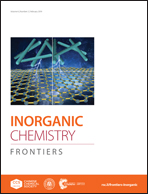Intense one-band near-infrared upconversion luminescence induced by using spontaneous polarization BiOCl sheet crystals as hosts for Yb3+ and Tm3+ ions†
Abstract
Rare earth (RE) doped nanophosphors, with nearly pure near-infrared to near-infrared (NIR-to-NIR) upconversion (UC), have great potential to revolutionize biological luminescent labels due to their deep tissue penetrability and high signal-to-noise ratios. Here, we report a new scheme that utilizes the anisotropic polarization of layered hosts to easily produce an efficient single-band NIR UC emission of Tm3+ ions. To verify this concept, BiOCl:Yb3+,Tm3+ microsheets and nanosheets are prepared, and their photoluminescence properties are characterized. Under excitation at 980 nm, Tm3+–Yb3+ co-doped BiOCl can produce a high NIR-to-visible UC emission ratio (I808 nm/I481 nm, over 1200) of Tm3+ ions, which can be carefully modified with the Yb3+ doping concentration. The experimental results indicate that the high environmental sensitivity of the 3H4 → 3H6 electric dipole transition (808 nm) of Tm3+ ions and its response to the oriented spontaneous internal electric field (IEF) of the BiOCl-layered host are mainly responsible for the intense, tunable one-band NIR UC emission property. This work provides new insight into the method for controlling the emission variance of energy levels of RE-doped UC systems and provides new directions for achieving nearly pure NIR-to-NIR UC in luminescent labelling probes for the field of biology.



 Please wait while we load your content...
Please wait while we load your content...